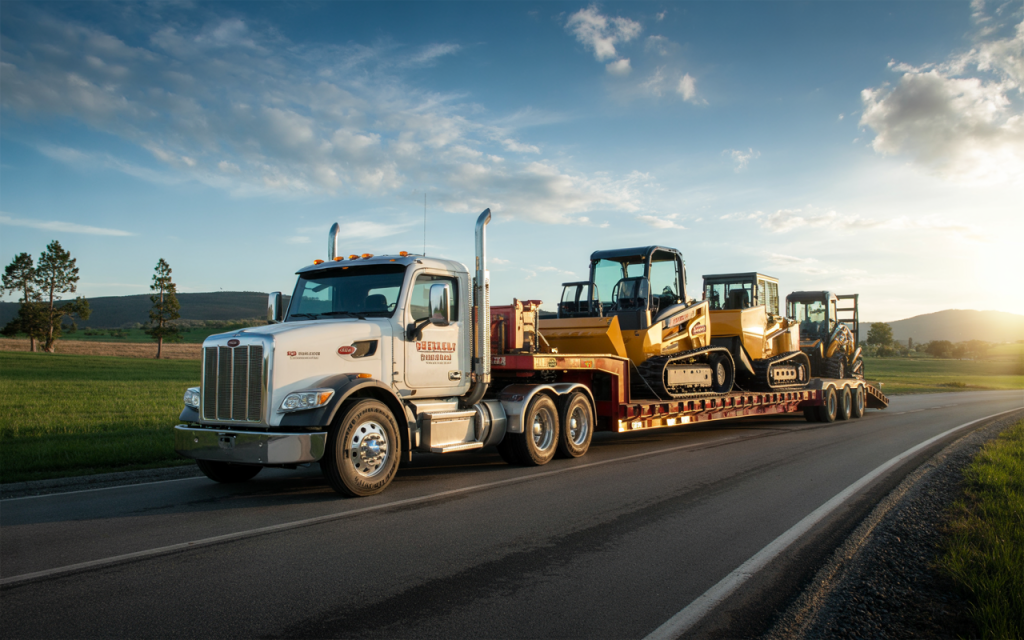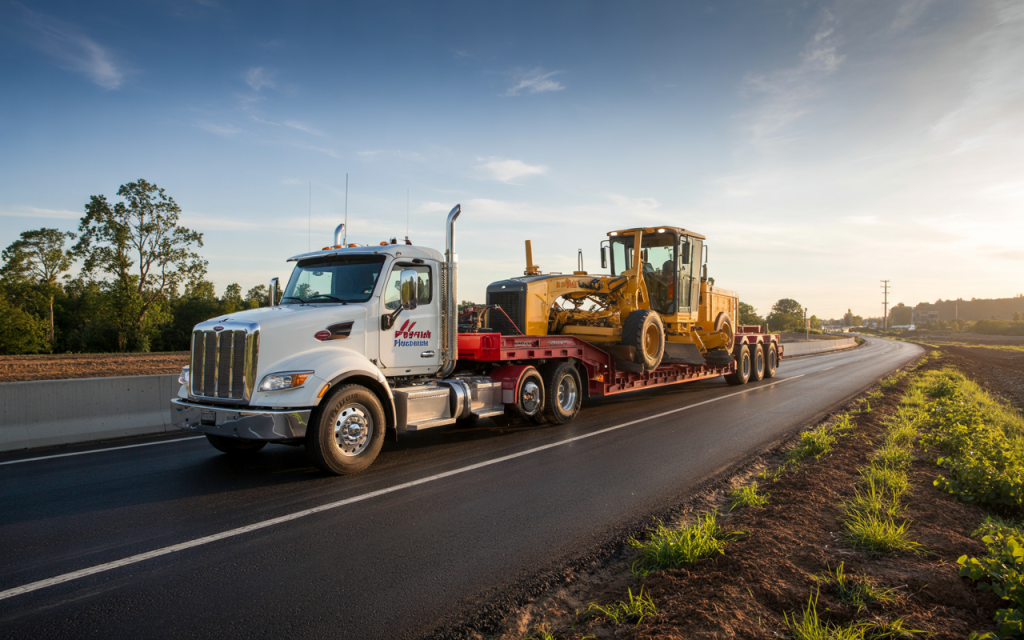Route Planning for Heavy Haul in Maryland: How We Manage, Avoid, and Prepare
Freedom Heavy Haul can offer expedited Pickup and Delivery for any size shipment anywhere in the USA. Contact us today for No Hassle, No Pressure Pricing.
Heavy haul route planning in Maryland is not just about mapping the shortest path. It’s about how we manage legal requirements, avoid logistical obstacles, and ensure that every move is safe, approved, and efficient.
In this article, you will learn about Route Planning for Heavy Haul in Maryland, and how we manage the route planning.
What Qualifies as Oversize or Overweight in Maryland?
In Maryland, a load is considered oversize or overweight if it exceeds any of the following:
- 80,000 pounds in total weight
- 8 feet 6 inches in width
- 13 feet 6 inches in height
- 70 feet in length
When a load surpasses these limits, we must apply for an oversize/overweight permit before transport. These permits are issued by the Maryland Department of Transportation via the Maryland One portal, which centralizes the application and approval process.
How We Handle Permitting and Regulatory Compliance
Before any equipment moves, we secure the proper permit based on the nature of the haul. For one-time shipments, we apply for a single-trip permit. For repeated or routine moves, we use a blanket permit.

Each permit outlines:
- Approved roads
- Permitted travel times
- Escort vehicle requirements
- Conditions based on the load type and dimensions
We manage these permits proactively to avoid last-minute delays or compliance issues.
How We Choose the Right Route
Route selection is one of the most critical steps in the planning process. We do not just look for the shortest or fastest option—we evaluate every road segment based on whether it can physically and legally support the load.
Key factors we consider include:
- Axle weights and total load weight
- Bridge weight restrictions
- Vertical clearance for overpasses and bridges
- Lane widths, turning radius, and road curvature
- Roadway conditions, construction zones, and seasonal limitations
We avoid routes that include tunnels or low-clearance structures, and we assess each path based on its ability to accommodate our equipment’s dimensions and weight.
Managing Maryland’s Infrastructure Constraints
Maryland’s infrastructure presents unique challenges that we plan around.
For example:
- In older urban areas like Baltimore, narrow roads and tight turns may require detours
- Some bridges may appear passable but are restricted based on structural limits
- Mountainous areas in Western Maryland require consideration of steep grades and vehicle strain
- Bay crossings and rural roads may limit available routes due to width or load restrictions
Understanding these constraints allows us to avoid problem areas and plan ahead.
How We Use Technology to Plan and Monitor Routes
We rely on advanced mapping and logistics software to visualize and simulate the route before the move begins. These tools allow us to:

- Identify low-clearance areas and tight curves
- Monitor live traffic conditions
- Track load movement in real time using GPS and telematics
- Adjust plans quickly if road conditions change
These systems help us avoid delays, reduce risk, and stay in full control throughout the move.
Coordinating with State and Local Agencies
A successful heavy haul in Maryland requires cooperation between multiple jurisdictions. Even when the route stays within the state, it often passes through several cities and counties, each with its own regulations.
We coordinate directly with:
- The MDOT State Highway Administration
- Local road authorities
- Police departments for escort approvals
- Utility companies if lines or poles need to be moved temporarily
This coordination ensures that the route is not only legal but also safe and feasible on the day of the move.
How We Prepare for Delays and Disruptions
We always expect the unexpected. That’s why we build contingency measures into every plan.

Our approach includes:
- Developing backup routes
- Performing advance route surveys or pilot runs
- Including buffer time in the transport schedule
- Keeping all teams informed with open communication channels
- Preparing traffic control support where needed
By preparing for potential disruptions—whether due to weather, construction, or accidents—we avoid costly delays and maintain control over the project timeline.
Real-World Examples of Route Planning in Action
When we moved a 200,000-pound transformer from the Port of Baltimore to a remote substation, the route included a barge transfer, nighttime transport to reduce traffic impact, and police escorts along multiple stretches. Each of those elements had to be pre-approved and tested.
In another case, we transported wind turbine blades through Western Maryland. The route included narrow, mountainous roads with limited turning space. We used extended trailers and pre-cleared staging areas to manage turns and keep the operation running smoothly.
These examples show how effective route planning solves complex problems before a single mile is driven.
Why Route Planning Matters for Every Heavy Haul in Maryland
Every decision we make during the planning stage—securing permits, mapping routes, coordinating with agencies, and preparing for disruptions—directly affects the outcome of the move.
Proper route planning protects your equipment, avoids regulatory violations, and ensures on-time delivery. Whether we’re moving cranes, transformers, or turbine blades, we manage each route with precision to make sure every load gets where it needs to be—safely and efficiently.
Frequently Asked Questions about Route Planning for Heavy Haul in Maryland
Here are some questions and answers about Route Planning for Heavy Haul in Maryland:
Do I need a permit for heavy haul trucking in Maryland?
Yes. Any load that exceeds Maryland’s legal limits for weight, width, height, or length requires a permit from the Maryland Department of Transportation.
What are the size limits before a load is considered oversize in Maryland?
A load is considered oversize if it exceeds 80,000 pounds in total weight, 8 feet 6 inches in width, 13 feet 6 inches in height, or 70 feet in length.
How long does it take to get a heavy haul permit in Maryland?
Processing time can vary, but most single-trip permits are approved within 1–3 business days. More complex moves may require additional time for review and coordination.
Can I haul oversize loads through Baltimore?
Yes, but with restrictions. Certain routes through Baltimore require escorts or limited travel hours. Some roads may be restricted due to tight turns, bridge limits, or infrastructure constraints.
What is Maryland One, and how does it help with permitting?
Maryland One is the state’s centralized online system for oversize/overweight permits. It allows carriers to apply for, manage, and track permit requests in one place.
Are escort vehicles required for heavy hauls in Maryland?
Escort vehicle requirements depend on the size and type of your load. The permit will specify when and where escorts are needed—typically for superloads or when traveling through urban areas.
What technology is used in heavy haul route planning?
We use geospatial mapping software, GPS tracking, and telematics to evaluate routes, monitor loads in real time, and respond quickly to any route-related issues.
What are some common route obstacles in Maryland?
Common challenges include low-clearance bridges, narrow roads in older towns, steep grades in Western Maryland, and limited access across the Chesapeake Bay.
Do I need local approval for each city or county my load travels through?
Yes. Even with a state permit, local jurisdictions may have additional rules. Coordination with city or county authorities—and in some cases, utility companies—is often necessary.
What happens if there is an emergency or route closure during transport?
We prepare a secondary route in advance and include buffer time in the schedule. Our team monitors transport conditions in real time and communicates any changes to all stakeholders.







